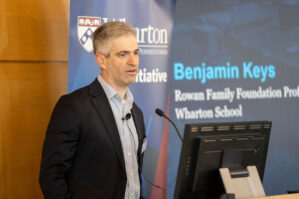In response to the devastating California wildfires, we are sharing a collection of actionable ESG Initiative research and insights published in the past eight years, to support those navigating disaster recovery.
- What the California Wildfires Mean for Insurers and Homeowners (2025)
- As People Still Recover From the LA Wildfires, What Can Business Leaders Do to Help? (2025)
- The Fiscal Impacts of Wildfires on California Municipalities (2020)
- Improving the Disaster Recovery of Low Income Households (2019)
- Simplifying and Speeding the Recovery Process (2018)

“A big challenge going forward is, in an environment where we’re going to see more frequent fires, how can we encourage development in those denser, safer locations, and try to steer clear of some of the riskiest spots.”
– Benjamin Keys, Rowan Family Foundation Professor, Professor of Real Estate, Professor of Finance
As People Still Recover From the LA Wildfires, What Can Business Leaders Do to Help? (2025)
In this episode of Wharton Business Daily, Michael Useem, Wharton Professor of Management, joins the show to discuss how business leaders can help those affected by the LA wildfires.

The Fiscal Impacts of Wildfires on California Municipalities (2020)
In this working paper, Penny Liao and Carolyn Kousky estimate the effects of wildfires on local public finance in California, looking in particular at various sub-components of municipal budgets. The findings depict a nuanced reality where physical impacts are mediated by policies and market adjustments. Using GIS data on fire perimeters, Liao and Kousky construct a measure of population exposure for each municipality, focusing on fires that affected at least 10% of a municipality’s population during 1995-2010. They match these wildfire occurrences to annual financial reports from the State Controller’s Office.
Main Findings:
- Revenues increase in the five years following the fire.
- Expenditures also increase over the same period.
- Overall impacts on municipal budgets are decidedly negative.
As wildfire risk escalates in California due to climate changes, the findings highlight an often-overlooked cost of natural disasters: impacts on municipal finance. Changes in municipal expenditures and revenues can trigger changes in tax assessments and also have impacts on service delivery, both with welfare impacts for residents.
Improving the Disaster Recovery of Low Income Households (2019)
The costs of natural disasters can be wide ranging, including not just property damage, but broader negative impacts on economic, social, and physical well-being. Research has shown that low income households and communities suffer disproportionately from disasters. Disasters can act as tipping points for families and individuals on the edge, pushing the marginally homeless into homelessness, those living paycheck-to-paycheck into debt and financial insecurity, and consuming any small savings that had been accumulated for housing, education, or other purposes.
In this Digital Dialogue, a collaboration between the Urban Institute’s Metropolitan Housing and Communities Policy Center and the ESG Initiative, experts weigh in on how federal disaster aid programs can be improved to assist low income households, and what policy changes need to be made to support effective recovery for low income households.
The contributors are unanimous in their calls for:
- Developing consistent triggers for disaster aid and recovery assistance based on disaster severity, general damage, and disproportionate damages for low-income households;
- Maintaining transparent, means-tested, and generally uniform eligibility thresholds;
- Prioritizing low-income households and low income-majority communities as the primary recipients for all mitigation, relief, and recovery programs;
- Developing partnerships and collaborations with organizations and residents in low-income communities to refine plans based on actual need and to directly serve residents;
- Expand the overall pool of resources, including mitigation funding, to more sufficiently fill unmet needs.
Simplifying and Speeding the Recovery Process (2018)
The recovery process for disaster victims can be long and complex. Government disaster aid is distributed through multiple agencies, each with their own processes and requirements. Many of these are duplicative and/or confusing for victims. Furthermore, much of the assistance provided is not targeted at those most in need and can take months or even years to reach victims. Delays in aid increase costs, prolong hardship, stall recovery, and can reverberate through the community for years to come.
In this Digital Dialogue experts weigh in on what specific policies, if implemented, could reduce post-disaster complexity for households, and what specific actions can speed delivery of disaster aid to victims.


